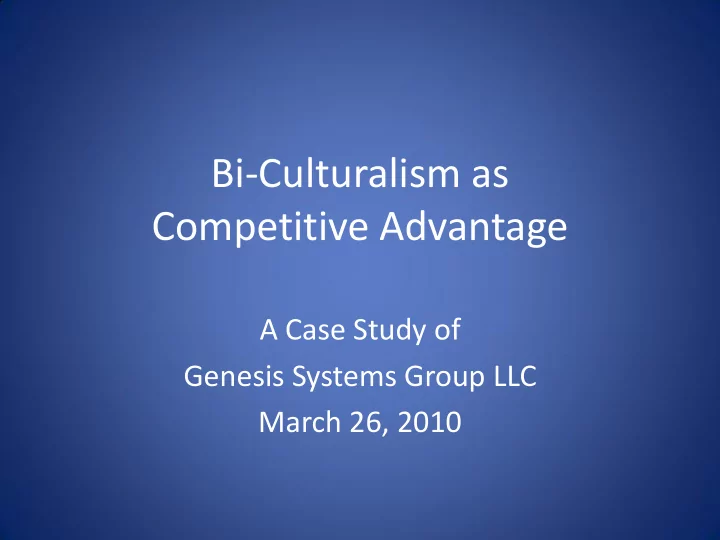

Bi-Culturalism as Competitive Advantage A Case Study of Genesis Systems Group LLC March 26, 2010
Organization • Description of Genesis Business – Joel (15 min) • Genesis’ Japanese Automotive Strategy – Makoto (15 min) • Anecdotes (10 min) • Questions and Answers (10 min)
Genesis Systems Group • Robotic Systems Integrator “Genesis is the premier global robotic automation partner to its clients” • Founded 1983 • HQ in Davenport, Iowa • Peak Revenues - $50M; (2009 – $26M) • Peak Employment – 200; (2009 – 125)
Industry Structure Each year, ~2000 Arc-Welding Robots are put into service in North America on average. ROBOT END USERS 90% of NA Arc-Weld Robots are used by less than 1,000 Companies Mostly Multi-Nationals Many are Foreign Enterprises! ROBOT INTEGRATORS 75% of NA Arc-Weld Robots are sold through ~20 Integrators Mostly Small Businesses ROBOT MANUFACTURERS 90% of Robots are produced by ~6 manufacturers Mostly Multi-Nationals
Globalization • Robot End Users are moving manufacturing more to the point of use of their products. • Robot End Users seek support for the manufacturing equipment in local markets.
• ~10 years ago, Genesis recognized that “globalization” of manufacturing could create an opportunity for our company to serve Japanese Transplant car companies. – At Genesis, we refer to them as “New Domestic” automotive. • We called upon a long-standing relationship with Makoto Matsuoka – which was a unique opportunity for Genesis (important point!). – Makoto brought understanding of differences in Japanese automotive.
How the Japanese Automotive Industry became strong in the world Accumulate special business culture with original business principles and organization over years: 1. People and Partners---Respect and Grow them 2. Keiretsu 3. Philosophy---Long Term Thinking 4. Process----Eliminate Waste 5. Problem Solving Best Quality, Lowest Cost, Shortest Lead Time, Best Safety, High Morale
People and Partners • Respect your extended network of partners and suppliers by challenging them and helping them improve (Ex: Aisin and their supplier relationship) • Develop people and teams who can follow company’s philosophy (Ex. Share Honda way within Honda Keiretsu Company)
Japanese Automotive Keiretsu Companies A set of companies with interlocking business relationships and shareholdings Toyota Motor Hond Motor Nissan Motor Matsuda/Mitsubishi Toyota Boshoku TS Tech Ikeda Bussan General Seating Seat Assembly Tier1 Tachi-S (Setex) Tachi-S Toyo Seat Aisin I B Tech Fuji Auto FAU Seat Component Tier 2 Shiroki Toyo Seat Toyo Seat Toyotetsu F Tech Yorozu Toa Undercarriage Hino Heritage KYB Showa Hitachi Damper DTR KYB Futaba KTH Unipress Eagle Wings Body Structure Toyotetsu Kikukchi Topre Aisin Sankei Aishin Katayama Door Shiroki Hashimoto Futaba Yutaka Calsonic Elsa Exhaust Sango Sankei
Philosophy • Business Decision with Trust and Mutual Respect • Management Decision based on Long Term Philosophy Ex: Genesis’ relationship with Japanese customers based on long term relationship
Process • Eliminate Waste (“ Muda ”) – “Cost down” versus “Price down” – Compact size, standardizing task, processes and components are the foundation of continuous improvement, employee empowerment and minimizing gameplaying Ex: Reduce # of Operators Reduce Floor Space Reduce Processes Reduce total capital investment
Problem Solving • Go see for yourself to thoroughly understand the situation (Genchi Genbutsu) • Become a learning organization through reflection (Hansei) and continuous improvement (Kaizen) • 5 Why investigation to find deeper countermeasures
How to Make Successful Business with Japanese Customers (Leading into Anecdotes)
Step1: Understand Cultural Difference - Language Difference Ex: Saying “No” in Japan is interpreted as very negative and “No” is the word that should be away from the business meetings - Work Ethic Difference Ex: Japanese have very strong loyalty for a company and people are strongly committed with company philosophy. Some people live for working, instead work for living - Relationship Difference Ex: Personal trusting relationship is directly related to business relationship in Japan
Step2: Adapt Differences and Learn Each Other • Establish relationship on both sides of the ocean! • Establish the competitive business strategy that can be accepted by local customers • Do not force them to follow one-way side culture and corporate philosophy • Being welcomed by different cultures can be critical to make successful business in global business environment
Questions ???? Comments >>> Did you learn anything?
Recommend
More recommend